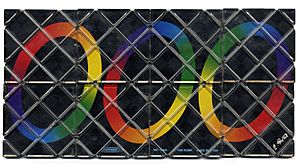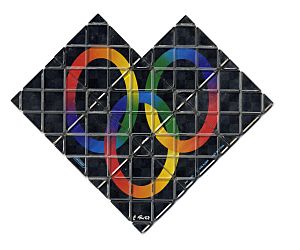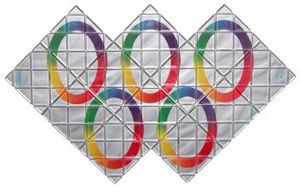Rubik's Magic facts for kids
Rubik's Magic is a cool mechanical puzzle created by Ernő Rubik. He's the same person who invented the famous Rubik's Cube! This puzzle was first made by Matchbox in the mid-1980s.
The puzzle starts as a flat rectangle made of eight square tiles. These tiles were originally black, but later versions had red squares with gold rings. Wires connect the tiles, letting you fold them in different ways, a bit like a toy called a Jacob's Ladder.
When you first look at the puzzle, the front side shows three separate, colorful rings. The back side has a mixed-up picture of three rings that are supposed to be connected. Your main goal is to fold the puzzle into a special heart-like shape. As you do this, you also need to fix the picture on the back so the rings connect perfectly.
Many people have found different ways to solve this puzzle. Really good players can change it from the starting rectangle to the solved heart shape in less than 2 seconds! Besides solving it, another fun challenge is to create different shapes, sometimes even 3D ones, with the puzzle.
Contents
What is Rubik's Magic Made Of?
The Rubik's Magic puzzle is designed so that you can only make 32 different 2x4 rectangle shapes with it. These shapes come from eight unique ways the puzzle's internal "chain" can be arranged.
One way to understand these arrangements is by looking at two key tiles. There's a "middle tile" that has parts of all three rings when the puzzle is solved. Then there's an "indicator tile" next to it, which has a yellow or orange ring segment.
Each chain arrangement has the middle tile either on the outside (O) or the inside (I) of the chain. If you place the indicator tile to the right of the middle tile, the ring segment on the indicator tile can be in one of four corners: upper left (UL), upper right (UR), lower left (LL), or lower right (LR). These combinations create eight different chain types.
How Are the Shapes Classified?
Just like the chains, the 2x4 rectangle forms of the puzzle can also be sorted. Each rectangle form is linked to one specific chain. Also, each chain can create four different rectangle forms. This depends on where the puzzle is folded in relation to the middle tile. For example, the starting position of the puzzle is called rectangle form OUR2.
Newer versions of the puzzle have rainbow colors and silver rings. A new challenge for these is matching both the silver rings and the colored squares, which can make it a bit trickier! There are also 64 different heart-shaped forms you can make.
World Records for Rubik's Magic
People used to compete to see who could solve the Rubik's Magic the fastest! The world record for solving it one time is an amazing 0.69 seconds. This record was set by Yuxuan Wang.
Yuxuan Wang also holds the record for the fastest average time over five solves, which was 0.76 seconds. He set this record at the Beijing Summer Open competition in 2011.
The World Cube Association (WCA) stopped recognizing Rubik's Magic as an official competition event in 2012. This means Yuxuan Wang's records are now the permanent world records for this puzzle!
Rubik's Magic: Master Edition
The Rubik's Magic: Master Edition, often called Master Magic, was also made by Matchbox in 1987. It's a bigger version of the original Rubik's Magic.
Instead of 8 tiles, the Master Edition has 12 tiles. These tiles are connected by nylon wires and form a larger 2x6 rectangle. This rectangle is about 10.5 cm (4.25 inches) wide and 32 cm (13 inches) long.
The goal of the Master Edition is similar to the original. You start with a 2x6 rectangle and need to fold it into a W-like shape. When you start, the front side shows five linked rings. Once you solve it into the W shape, the back side of the puzzle will show five rings that are unlinked.
Even though it has more tiles, some people find the Master Edition simpler to solve than the original Rubik's Magic. Because it has more hinges, you can often work on one part of the puzzle without affecting the others too much. The fastest way to solve it takes at least 16 quarter-turn moves, but there are many different ways to find a solution. The Master Edition was also an official event for the World Cube Association (WCA) from 2003 to 2012.
Images for kids










